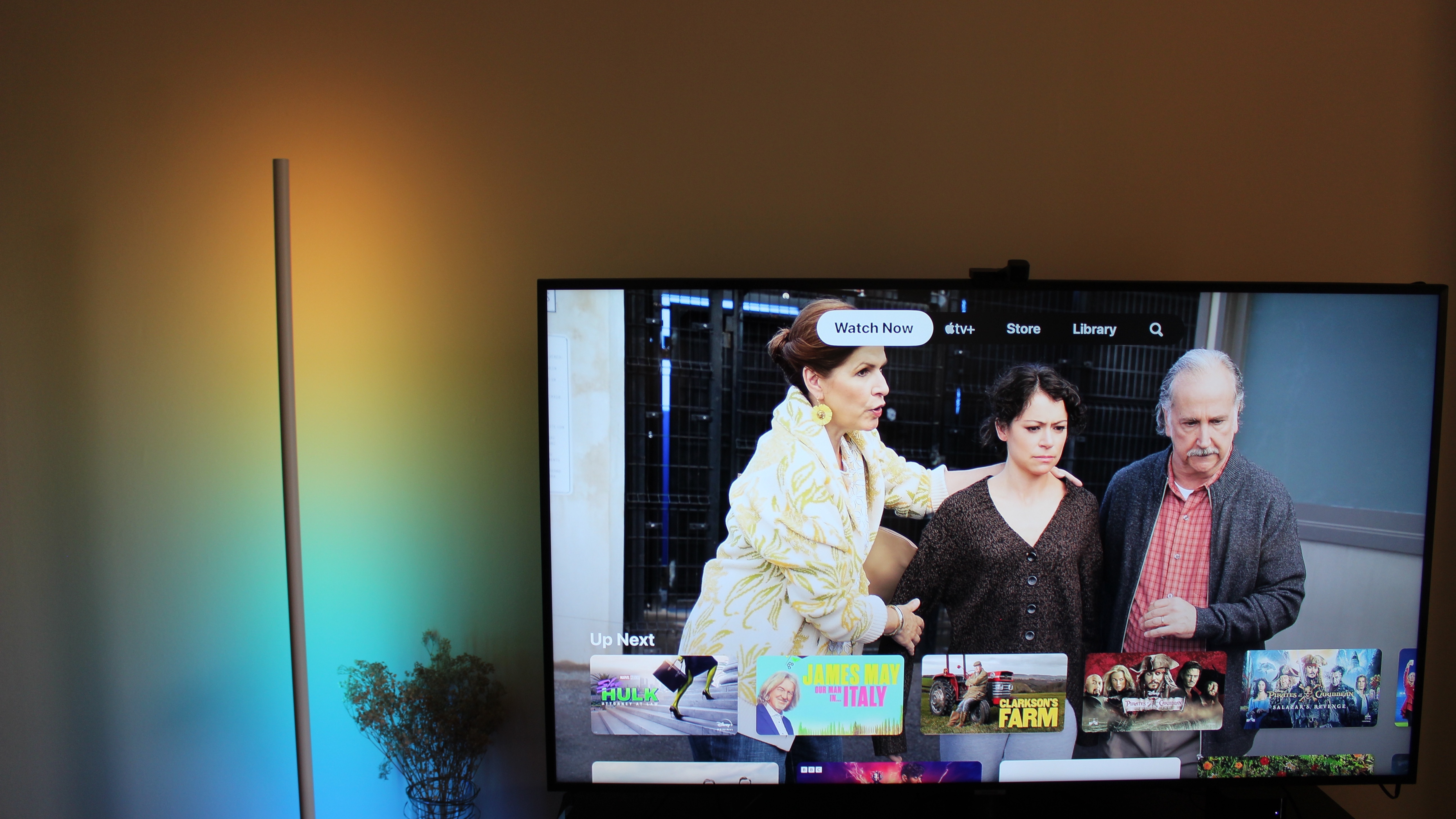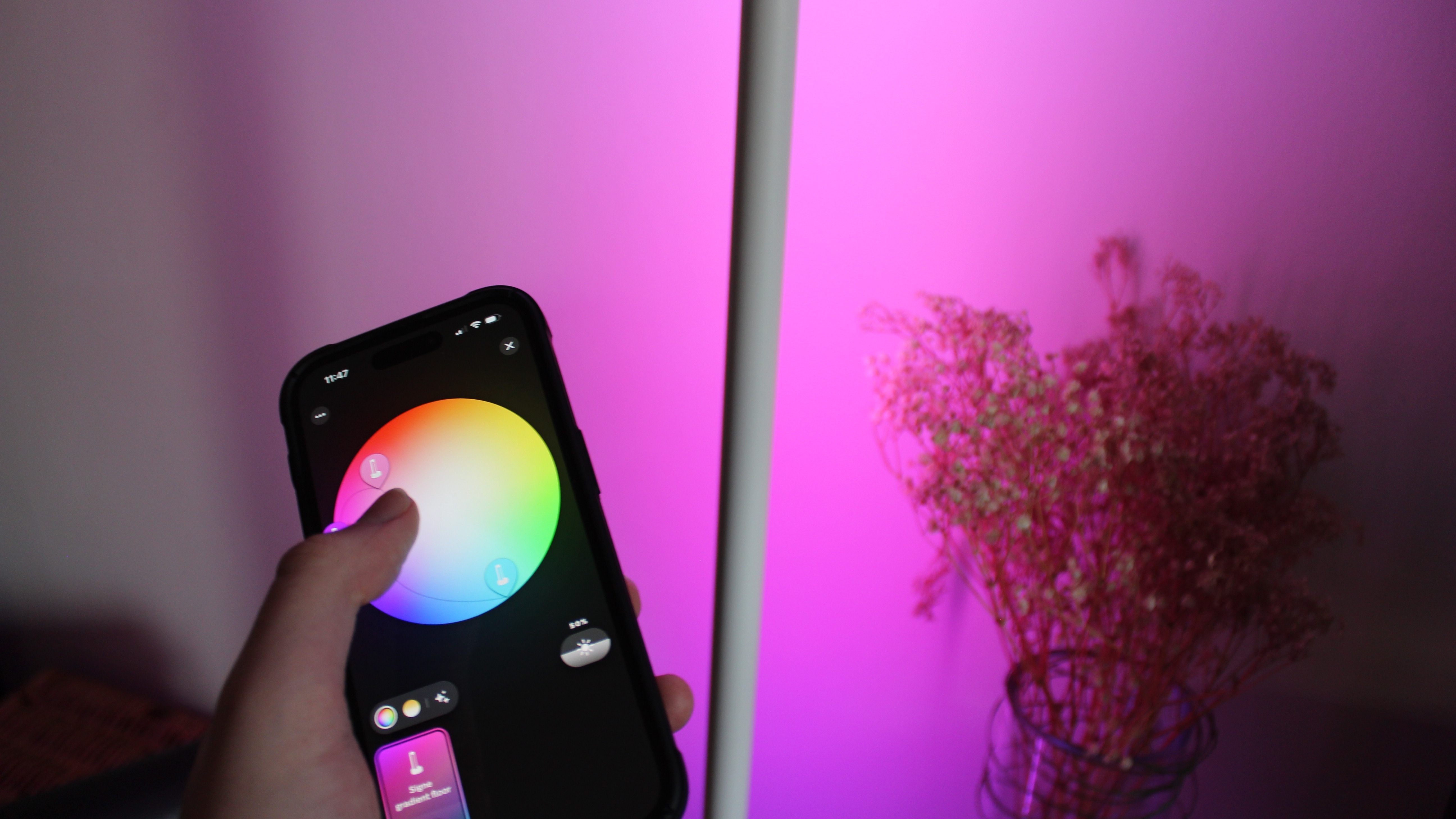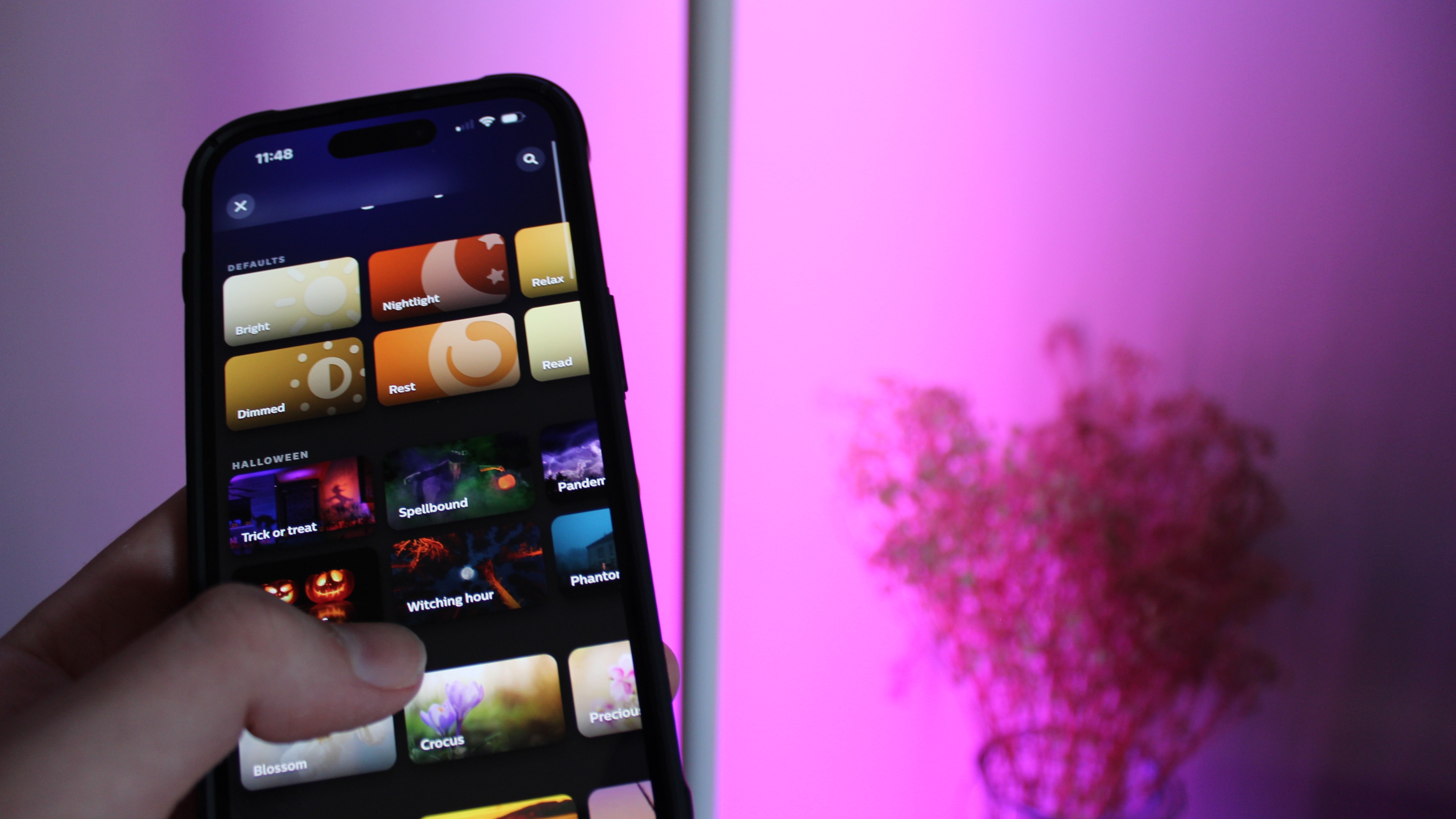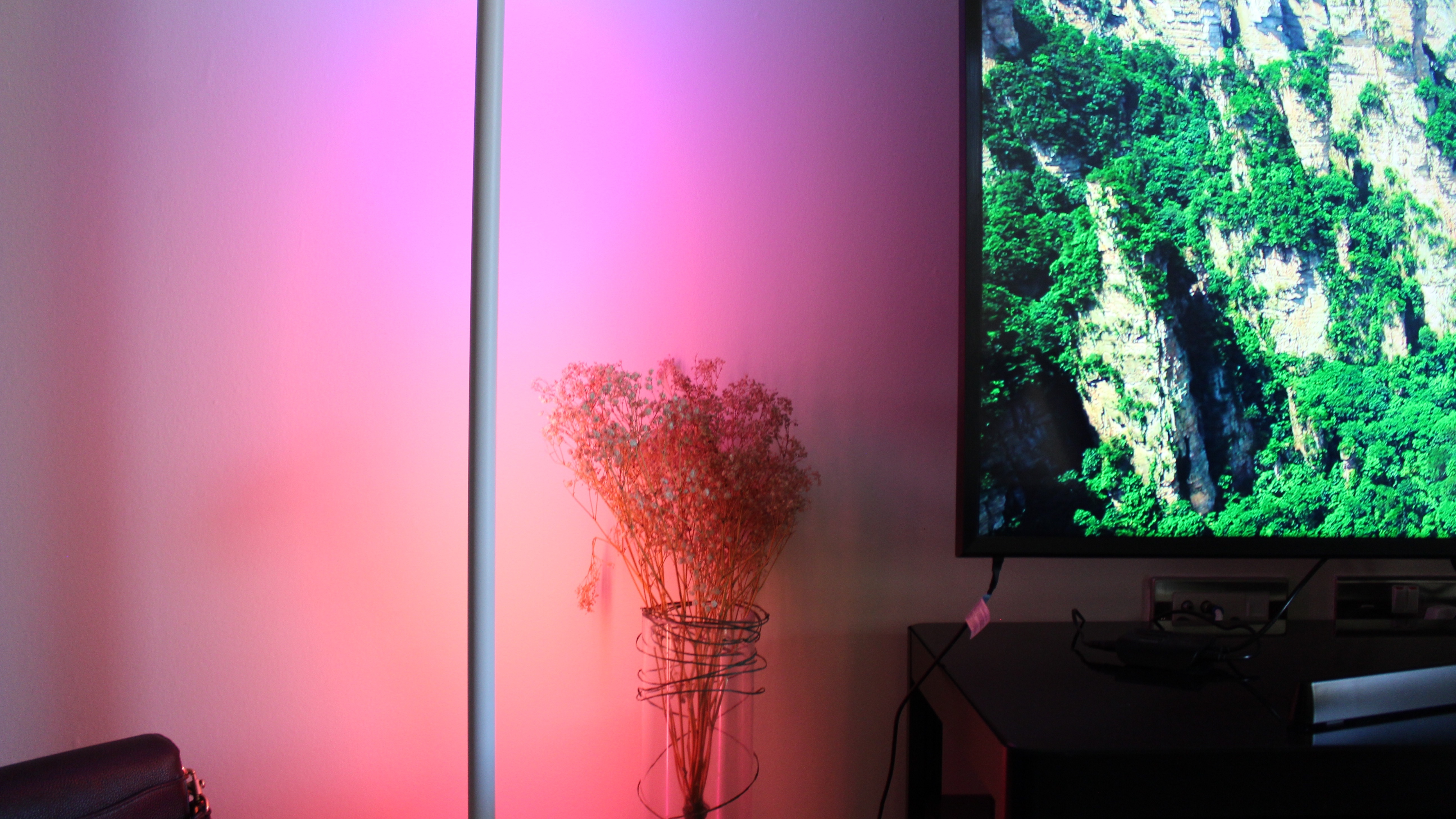iMore Verdict
A tremendous floor lamp with bright, vivid colors and great controls, but needs an extra Hue Bridge to make it really sing for Apple users.
Pros
- +
+ Extremely good design and quality
- +
+ Very easy to set up, works out of the box
- +
+ Excellent lighting in both white and color modes
- +
+ App with limitless customization
Cons
- -
— Expensive
- -
— Needs Hue Bridge to use with HomeKit and Siri
- -
— Works best as part of a larger ecosystem, which is more expensive
You can always trust iMore.
The Philips Hue Signe gradient floor lamp has been an absolute delight to use and enjoy since it entered our home a couple of weeks ago. With its new range of Signe gradient lamps (there’s also a table version), Philips Hue has tapped even deeper into the market of delightful, high-quality smart home lighting that its brand has become synonymous with, so much so that even Apple’s website proudly sells a slew of its products.
The Philips Hue Signe gradient floor lamp is another example of Hue’s great design and smart home savvy, brought to life in a way that can light up any room, either as a standalone device or as part of a chorus of Hue accessories.
Philips Hue Bridge owners and people already invested in the ecosystem will find this an easier purchase. Still, a hefty price of $329/£279 might make the eyes water for first-time Hue buyers and those not exposed to the wonders of the smart home. Here’s our review.

Philips Hue Signe Gradient Floor Lamp: Price and availability

The Philips Hue Signe gradient floor lamp is available from the Philips Hue website, Apple.com (it’s unlikely to be stocked in stores due to its size), and Amazon.
It’s available in three fetching colors, black, white, and oak. The latter, pictured and reviewed here, retails for the slightly higher price of $349/£299 due to its more premium finish; the other two colors are aluminum. Philips and Apple offer friendly shipping, returns, and a 2-year warranty. In the box, you get the lamp and a power supply.
Philips Hue Signe Gradient Floor Lamp: What I love

There is plenty to love about the Philips Hue Signe. From the get-go, it is super simple to use and set up. It comes ready to plug in and use and will turn on as soon as you fire the plug into the outlet. There’s no hassle and no messing around, which is excellent, as the smart home can often be a minefield of confusing setups and connections.
iMore offers spot-on advice and guidance from our team of experts, with decades of Apple device experience to lean on. Learn more with iMore!
The only other thing you need to do is download the Philips Hue app, which will quietly and quickly connect to your lamp via Bluetooth.
Taking it out of the box, I was really blown away by the strength and quality of the design of the Signe. Our oak model has a lovely wood-toned, circular base and an otherwise-aluminum construction. It’s incredibly solid and well-built, with no blemishes or wonkiness. Hue might be the most expensive smart lighting brand on the market, but there’s no denying you’re getting premium build quality at the very least.
The next thing I was blown away by was the size; the floor lamp is really quite tall for a premium strip of LED, 57.4 inches. Otherwise, it has a tiny footprint of less than 4.5- inches, which guarantees it will fit in all but the tiniest of spaces. Indeed, it has a vastly smaller footprint than a conventional floor lamp, especially one with a tripod.
The Signe floor lamp really shines (sorry) when you switch it on (sorry again). The Signe puts out 2,550 lumens of light at full tilt thanks to its built-in 29W LED. It is very, and I mean very, bright. There are two main modes, white and color. The former means your lamp can be used as a very capable (if expensive) light for day-to-day tasks and activities. The Signe has been hijacked by my Wife to bathe her home office setup in a tremendous warm glow that provides ambiance and light at all times of the day. While you often think of Philips Hue as a symphony of color and dancing RGB, the Signe’s white light performance is not to be overlooked and is a key facet of its usefulness. A very intuitive and specific color wheel lets you choose from a warm orange glow, laboratory white, or anything in between. The Signe floor lamp is worth your consideration, even as a more conventional lighting fixture, but it really shines when the colors come out to play.

The Signe’s colors are electric. Again powered by a color wheel, you can choose between one, two, and three colors across the LED strip, making for a limitless combination of choices. This can be done manually, or you can choose from the innumerable scenes in the Hue scene gallery, which are perfect for inspiration if you’re unsure what kind of lights look best. There’s everything from blossom and crocus to sunsets, Miami party vibes, Chinatown red, incredible Arctic Aurora, and more. Even holiday and Halloween scenes get updated throughout the year, and each scene has its own custom level of optimum brightness that you can adjust. You can also tweak the colors yourself for optimum personalization.
The scale and brilliance of Signe’s colors mean you can justify the purchase of this lamp for almost any purpose. It could be a brilliant, fluorescent addition to a gaming cave, the perfect complement to a home cinema system, or a soft, warm light for your bedroom. The limitless customization gives you not only brilliant combinations of light but also diversity of use. The lamp is primarily designed to face a wall and bathe it in a soft glow. However, I’ve also enjoyed using it as a very long spotlight to light up a desk with brighter light. It works well both ways, adding to its diverse uses.
Thanks to its Bluetooth connectivity, the Signe Floor Lamp is extremely easy to connect to and use, with just a couple of taps needed inside the Philips Hue app to get connected. The app also manages updates for the lamp and is the source of all your customization needs and the aforementioned scene gallery, which is one of my favorite features. Users who want voice control through either Amazon Alexa or Google Home can also set up that feature from within the app. Apple’s HomeKit is a little trickier, which is where the Signe falls down just a tad.
Philips Hue Signe Gradient Floor Lamp: What I don't love

As mentioned, there is a quirk when it comes to HomeKit connectivity; you’ll need the Philips Hue Bridge to control your Signe Floor Lamp using Siri and Apple’s Home app. Of course, this is fine if you already own a Philips Hue Bridge, but if not, it’s an extra expense you’ll need to foot to the tune of $60. The Bridge is the cornerstone of the Hue lighting ecosystem and foundational if you want to make the most of HomeKit, timers, motion sensors, scenes, and more. It is also vital if you have multiple Philips Hue devices or want to use Siri to control your lights. This being my first product, I was happy to dip in an out of the app as needed to control the lamp. Still, if you have more products or are trying to build a more comprehensive setup, Apple users will find the Bridge an indispensable bit of kit, adding weight to an already costly investment, which brings me to the biggest drawback of the Signe Floor lamp. The Price.
At a hefty $329 ($349 for our unit), the Signe Floor Lamp is definitely on the expensive side. As noted, Philips Hue is synonymous with premium smart lighting, including prices to match. It should be noted that the price isn’t uncharacteristic for Hue’s lineup, but first-time buyers will probably find themselves balking at the price tag. Perhaps this criticism is unfair; check out any department store or retailer, and you’ll probably find “designer” lights that cost way more than the Hue Signe and don’t have any of its smart features. There are, however, a few cheaper options out there that we’ll come onto in a minute.
While Matter’s new Smart Home standard promises to herald a new age of connectivity across devices like smart lights, right now, if you invest in the Hue ecosystem, you’ll need to keep investing in the Hue ecosystem to get the most out of it, so another thing to bear in mind is that this probably won’t end up being your last smart light purchase, so make sure it’s the right one for your needs before you start!
Really though, there are very few downsides to owning a Philips Hue light, especially the Signe Floor Lamp, which excels in delivering bright and vibrant colors to suit all rooms and needs.
Philips Hue Signe Gradient Floor Lamp: Competition

Focussing exclusively on tall, smart floor lamps, there aren’t many competing devices to choose from when it comes to the Hue Signe Floor lamp. The most notable rival is the Govee RGBIC Floor Lamp. This is also an LED floor lamp that comes with RGB options and a design very similar to the Signe. Govee has emulated many of Philips’ Hue products at notably lower prices. I use Govee’s lamp, TV strip, and lighting bars, and I like them all. Indeed, they’re not the same quality in terms of build and materials, but they do at least offer much of the same functionality, including a decent app to control multiple lights.
Interestingly, Govee’s app works with Shortcuts, so you can create voice commands for your phone that will turn lights on and off, an option you don’t get with the Signe Lamp. The Govee option has music sync and 1000 lumens of brightness, considerably less than the Signe. However, you can pick one up on Amazon for just $99, which is quite the price difference. There’s also a slightly different design option with 1500 lumens of brightness for $150, again a significant saving.
Philips Hue Signe Gradient Floor Lamp: Should you buy it?

You should buy this if...
- You want the most premium smart floor lamp money can buy
- You need excellent white and RGB performance
- You’re looking to decorate a bedroom or gaming space with ambient light
- You want a light that works with Apple HomeKit and Siri
You should not buy this if...
- You want a budget floor lamp option
- You don’t want a smart light
- You don’t need HomeKit or other smart home compatibility
Philips Hue Signe Gradient Floor Lamp: Verdict

The Philips Hue Signe Gradient Floor lamp is a tremendous bit of kit. An incredibly bright and versatile lamp with excellent connectivity and limitless customization possibilities. That means it can serve almost any need, from lighting up the most extreme gaming setup to providing a warm glow at bedtime. It’s expensive for a smart light, but you can also buy regular lamps that cost more; those make the Signe look like a steal. The only compromise I can see is the need to purchase a separate Hue bridge to take full advantage of Siri and HomeKit compatibility, especially for those already invested in the Hue ecosystem or those looking to build one. I’ve loved having the Signe in our home and would heartily recommend it to anyone with the money to spend.

Bottom line: A stunning smart lamp with a price to match.
Pros
- Extremely good design and quality
- Very easy to set up, works out of the box
- Excellent lighting in both white and color modes
- App with limitless customization
Cons
- Expensive
- Needs Hue Bridge to use with HomeKit and Siri
- Works best as part of a larger ecosystem, which is more expensive

Stephen Warwick has written about Apple for five years at iMore and previously elsewhere. He covers all of iMore's latest breaking news regarding all of Apple's products and services, both hardware and software. Stephen has interviewed industry experts in a range of fields including finance, litigation, security, and more. He also specializes in curating and reviewing audio hardware and has experience beyond journalism in sound engineering, production, and design.
Before becoming a writer Stephen studied Ancient History at University and also worked at Apple for more than two years. Stephen is also a host on the iMore show, a weekly podcast recorded live that discusses the latest in breaking Apple news, as well as featuring fun trivia about all things Apple. Follow him on Twitter @stephenwarwick9


